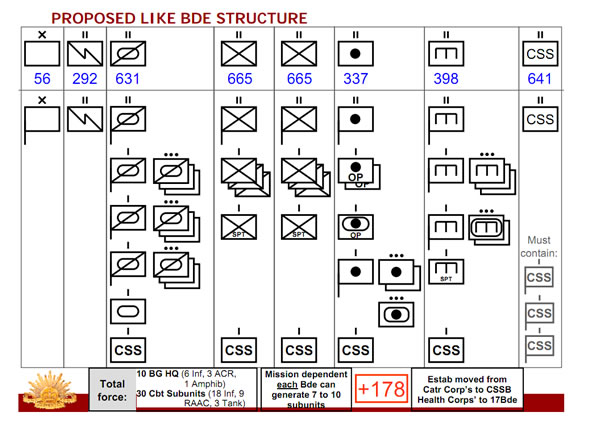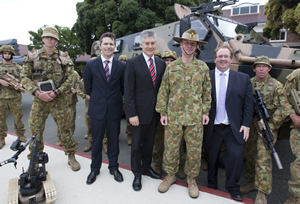Plan BeerSheba announced by the Australian Defence on December 12, 2011 aims to ensure that the country continues to contribute forces to operations including Afghanistan and successfully transition to a force that is able to respond effectively to future challenges, including humanitarian assistance and disaster relief and other operations. The restructuring of the ground forces designed to achieve a greater integration of the Regular Army and reserve component, introduce amphibious operational capabilities of the Australian land forces.

Planning for the next phase of the Adaptive Army Campaign, the Army will form three new Multi-role Maneuver Brigades with the 1st, 3rd and 7th Brigades. Each brigade will be supported by two reserve brigades. Adapting to a mission dependent formation, each brigade will be able to generate 7-10 subunits. Under Plan BeerSheba ten battle group maneuver units will be formed to support this formation. The Multi-Role Maneuver Brigades will include infantry, armor, artillery, engineers, logistics and communications and will be fundamentally alike in structure, to enable sustained operations within a new 36-month Force Generation Cycle. The six Army Reserve Brigades currently operating under the 2 Division forming the Reserve Force will be more focused on stability operations. These units will be structurally aligned with their regular counterparts. Through the training cycles they will be involved in major exercises with their partnered Multi-role Maneuver Brigades.
The new Landing Helicopter Dock (LHD) ships represent a fundamental shift in how Army will deploy land forces and conduct operations in response to the full spectrum of scenarios in the future. Under Plan BeerSheba the Army will dedicate its 2nd Battalion, Royal Australian Regiment (2RAR) for amphibious operations, forming the core capability to support humanitarian and disaster relief operations, particularly in the Southern Pacific. As part of this move, Army units will be trained with the Royal Australian Navy new LHD ships and other amphibious platforms.
As part of this program the Army’s 2nd Division (Reserve) will be fielding the Bushmaster Protected Mobility Vehicles gaining protected transport. Units receiving the armored vehicles include the Melbourne based 4th Brigade / 19th Prince of Wales Light Horse squadron and a new armored squadron to be based in Queensland. According to the Commander 2nd Division, Major General Craig Williams, the reserve division will be realigned with the regular army, with two reserve brigades linked to each multi-role maneuver brigade.

“The 2nd Division will be aligned with the 36 month Force Generation Cycle and assigned preparedness levels.” Williams said, “There will be a significant increase in the operational focus of the Reserve which will be effected through the development of habitual relationships between reserve brigades and the regular multi-role maneuver brigades.” Major General Williams added.
Major General Jim Barry (Retd), President, Defence Reserves Association (DRA) calling the new plan , Major General Jim Barry (Retd) describes the new plan as “the most important structural change for the Army Reserve in decades. There is now a defined operational focus which the DRA has been advocating for some time.” Barry said.

“It is very difficult to predict what types of operations we will have in our immediate future and that augers for a force that is better balanced than what we have at the moment.” Lt. General David Morrison, Chief of the Australian Army explained, “The structures that have formed around our First Brigade in Darwin or our Third Brigade in Townsville or our Seventh Brigade in Brisbane have served Australia well, without doubt and all of the plans that drew those Brigades into that shape during the ’70s and early ’80s, I think, has shown the sense of that, at the time. But over the last 12 years, with the types of operations that we’ve been involved in, we’ve had to replace units in operational theaters that haven’t looked like those forces that they’re taking over from.”
“We’ve replaced light infantry with mechanised infantry and we’ve replaced them in turn with motorised infantry. We had to re-skill people and prepare them in a different way for the types of operations they had been asked to do.” Morrison added, “It’s been pretty – it’s met what we’ve been required and, as I said, the performance of our soldiers, I think, has been second to none. But it has been less than efficient. What we need is an army that is better balanced across its force structure, both in terms of its regular forces and its reserve forces.”



















